Stock Market Shrugs off GM Bankruptcy
Stock-Markets / Financial Markets 2009 May 31, 2009 - 10:19 AM GMT Main Street takes a hit in GM bankruptcy - The loser in a General Motors Corp. bankruptcy would be Main Street, not Wall Street, said a lawyer who represented Chrysler LLC’s dissident lenders and is trying to organize bondholders who hold up to $7 billion in GM’s debt. What’s being offered is the U.S.-backed plan to give the American and Canadian governments as much as 69 percent of the equity and a 17.5 percent trust for unions, while bondholders only get 10%. GM plans to file for bankruptcy on June 1, people familiar with the matter said.
Main Street takes a hit in GM bankruptcy - The loser in a General Motors Corp. bankruptcy would be Main Street, not Wall Street, said a lawyer who represented Chrysler LLC’s dissident lenders and is trying to organize bondholders who hold up to $7 billion in GM’s debt. What’s being offered is the U.S.-backed plan to give the American and Canadian governments as much as 69 percent of the equity and a 17.5 percent trust for unions, while bondholders only get 10%. GM plans to file for bankruptcy on June 1, people familiar with the matter said.
The difference with GM is that, whereas the ‘bad guys’ in Chrysler were hedge funds, who Obama called ‘speculators,’ here they’re Main Street -- individual retirees who bought bonds when bankruptcy was unthinkable.
Business is still contracting…
U.S. business activity contracted at a faster pace than forecast this month as orders and employment dropped. The Institute for Supply Management-Chicago Inc. said today its business barometer decreased to 34.9 from 40.1 in April. Readings below 50 signal a contraction.
…while consumer confidence surges.
Confidence among U.S. consumers rose this month to the highest since September, reinforcing signs that the worst recession in half a century is abating. The Reuters/University of Michigan final index of consumer sentiment increased to 68.7, more than forecast, from 65.1 in April. The preliminary reading for May was 67.9. Isn’t this a little premature?
The market may get another wind.
 -- U.S. stocks rose for a second day as commodities headed for their biggest monthly rally in 34 years on speculation a rebound in the global economy and rising bond yields will spur higher prices. Benchmark indexes were whipsawed earlier as a gauge of business activity near Chicago unexpectedly decreased, then the Reuters/University of Michigan index of consumer confidence for May came in slightly better than forecast at 68.7. Confidence may be following the “wealth effect,” i.e. rising markets boost confidence.
-- U.S. stocks rose for a second day as commodities headed for their biggest monthly rally in 34 years on speculation a rebound in the global economy and rising bond yields will spur higher prices. Benchmark indexes were whipsawed earlier as a gauge of business activity near Chicago unexpectedly decreased, then the Reuters/University of Michigan index of consumer confidence for May came in slightly better than forecast at 68.7. Confidence may be following the “wealth effect,” i.e. rising markets boost confidence.
U. S. borrowing spree continues.
 -- Treasuries fell for their second monthly loss, pushing 10-year yields up the most in almost six years, as President Barack Obama’s record borrowing spree overwhelmed Federal Reserve efforts to cap interest rates. South Korea’s National Pension Service, the nation’s largest investor, plans to reduce the weighting of U.S. bonds in its holdings, the government said in a statement.
-- Treasuries fell for their second monthly loss, pushing 10-year yields up the most in almost six years, as President Barack Obama’s record borrowing spree overwhelmed Federal Reserve efforts to cap interest rates. South Korea’s National Pension Service, the nation’s largest investor, plans to reduce the weighting of U.S. bonds in its holdings, the government said in a statement.
Gold breaks out to new high.
 Gold rose in Asia, heading for the first monthly increase in three as a tumbling dollar boosted demand for the precious metal as a store of value.
Gold rose in Asia, heading for the first monthly increase in three as a tumbling dollar boosted demand for the precious metal as a store of value.
The dollar has slumped 5 percent against a basket of six major currencies including the yen and the euro this month, while gold has jumped 8 percent in the same period. Bullion reached $965.04 yesterday, the highest in more than two months.
Japanese stocks still rising.
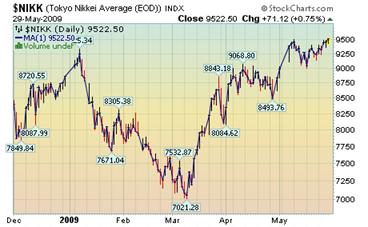 -- Japanese stocks rose, extending weekly and monthly gains, after oil hit a six-month high and sea cargo rates surged, overshadowing unemployment at a five-year high. The Nikkei added 3.2 percent on the week and 7.9 percent in May, the third-straight monthly climb. The Topix had respective gains of 2.5 percent and 7.2 percent. Companies on the Topix traded at 1.15 times book value yesterday, the highest level since Oct. 6.
-- Japanese stocks rose, extending weekly and monthly gains, after oil hit a six-month high and sea cargo rates surged, overshadowing unemployment at a five-year high. The Nikkei added 3.2 percent on the week and 7.9 percent in May, the third-straight monthly climb. The Topix had respective gains of 2.5 percent and 7.2 percent. Companies on the Topix traded at 1.15 times book value yesterday, the highest level since Oct. 6.
China’s economists raise growth forecasts.
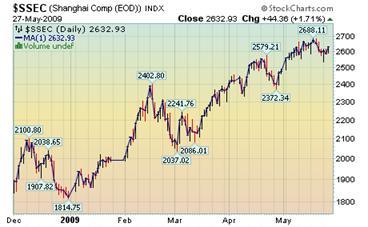 -- China’s growth prospects have improved from three months ago, even after accounting for drops in steel and electricity output and the risk of a manufacturing contraction this month, economists’ forecasts show. The world’s third-largest economy will expand 7.5 percent this year, according to the median estimate of 14 economists surveyed by Bloomberg News, up from a 7.1 percent forecast in February. Gross domestic product expanded 6.1 percent in the first quarter, the slowest pace in almost 10 years.
-- China’s growth prospects have improved from three months ago, even after accounting for drops in steel and electricity output and the risk of a manufacturing contraction this month, economists’ forecasts show. The world’s third-largest economy will expand 7.5 percent this year, according to the median estimate of 14 economists surveyed by Bloomberg News, up from a 7.1 percent forecast in February. Gross domestic product expanded 6.1 percent in the first quarter, the slowest pace in almost 10 years.
The dollar declines as the economy seems to improve.
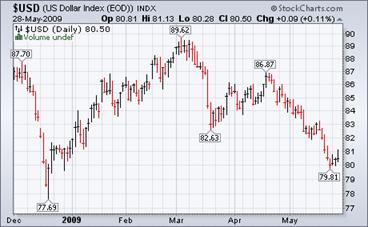 -- The dollar was broadly weaker Thursday as worries mounted regarding the massive size of upcoming U.S. government debt issuance and its influence in pushing Treasury yields higher. The higher yields on Treasury’s - the 10-year touched 3.76%, nearly a full percentage point higher from a couple months ago - came amid signs the U.S. economy is starting to improve.
-- The dollar was broadly weaker Thursday as worries mounted regarding the massive size of upcoming U.S. government debt issuance and its influence in pushing Treasury yields higher. The higher yields on Treasury’s - the 10-year touched 3.76%, nearly a full percentage point higher from a couple months ago - came amid signs the U.S. economy is starting to improve.
Foreclosures hit prime borrowers hard.
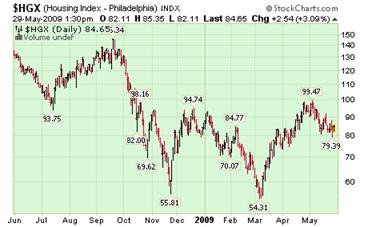 One of eight U.S. households with a mortgage ended the first quarter late on loan payments or in the foreclosure process in a crisis that will persist for at least another year until unemployment peaks, the Mortgage Bankers Association said on Thursday. U.S. unemployment in April reached its highest rate in more than a quarter century and is still rising, helping propel mortgage delinquencies and foreclosures to record high. Such economic weakness drove up foreclosures of prime fixed-rate loans, which are made to the most creditworthy borrowers. The foreclosure rate on those loans doubled in the last year and represented the largest share of new foreclosures in the first three months of this year.
One of eight U.S. households with a mortgage ended the first quarter late on loan payments or in the foreclosure process in a crisis that will persist for at least another year until unemployment peaks, the Mortgage Bankers Association said on Thursday. U.S. unemployment in April reached its highest rate in more than a quarter century and is still rising, helping propel mortgage delinquencies and foreclosures to record high. Such economic weakness drove up foreclosures of prime fixed-rate loans, which are made to the most creditworthy borrowers. The foreclosure rate on those loans doubled in the last year and represented the largest share of new foreclosures in the first three months of this year.
Crude oil driving gasoline prices higher.
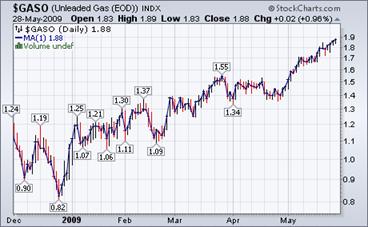 Energy Information Administration Weekly Report suggests that, “For the fourth week in a row the national average price for regular gasoline increased, jumping almost 13 cents to $2.44 per gallon. Despite the cumulative increase of nearly 39 cents over the past four weeks, the price was still $1.50 below the average of a year ago.”
Energy Information Administration Weekly Report suggests that, “For the fourth week in a row the national average price for regular gasoline increased, jumping almost 13 cents to $2.44 per gallon. Despite the cumulative increase of nearly 39 cents over the past four weeks, the price was still $1.50 below the average of a year ago.”
Economic downturn reflected in natural gas prices.
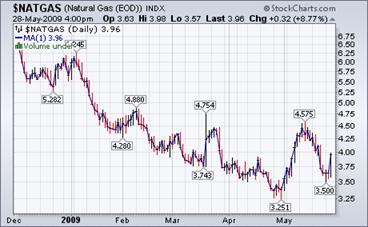 The Energy Information Agency’s Natural Gas Weekly Update reports, “Significant price declines in all markets in the Lower 48 States during the report week erased a mid-month run-up in spot natural gas prices. Many spot prices are trading at near 6-year lows, with no daily market prices exceeding $4 per MMBtu and many below $3. The lack of significant weather-related demand during the report week and continued concerns over the economy likely contributed to a decrease in (the price of natural gas).”
The Energy Information Agency’s Natural Gas Weekly Update reports, “Significant price declines in all markets in the Lower 48 States during the report week erased a mid-month run-up in spot natural gas prices. Many spot prices are trading at near 6-year lows, with no daily market prices exceeding $4 per MMBtu and many below $3. The lack of significant weather-related demand during the report week and continued concerns over the economy likely contributed to a decrease in (the price of natural gas).”
You may kiss a refi goodbye.
Well, so much for the promise of green shoots. Some folks who still had equity in their home have recently attempted to refinance their mortgages to get the much publicized lower rate. Fat chance! Every one of the refi attempts that I am aware of failed.
Mish explains how those attractive rates were never to be as the mortgage market literally seized up. “ … ‘applicants’ with loans in process were awaiting the magical 4.5% rate before they lock -- a large percentage of these suddenly died yesterday. To make matters worse, after 90-days much of the paperwork (much taken at the date of application) within the file becomes stale-dated and has to be re-done with new dates -- if rates don’t come down quickly many will have to be cancelled out of the lender’s system. To add insult to mortal injury, unless this spike in rates corrects quickly, a large percentage of unlocked purchases and refis will have to be denied because at the higher interest rate level, borrowers do not qualify any longer.” Up-front fees will probably never be refunded.
Ten Principles for a Black Swan-proof world.
No socialisation of losses and privatisation of gains. Whatever may need to be bailed out should be nationalized; whatever does not need a bail-out should be free, small and risk-bearing.
We have managed to combine the worst of capitalism and socialism. In France in the
1980s, the socialists took over the banks. In the US in the 2000s, the banks took over the government. This is surreal.
Our Investment Advisor Registration is on the Web
We are in the process of updating our website at www.thepracticalinvestor.com to have more information on our services. Log on and click on Advisor Registration to get more details.
If you are a client or wish to become one, please make an appointment to discuss our investment strategies by calling Connie or Tony at (517) 699-1554, ext 10 or 11. Or e-mail us at tpi@thepracticalinvestor.com .
Anthony M. Cherniawski,
President and CIO
http://www.thepracticalinvestor.com
As a State Registered Investment Advisor, The Practical Investor (TPI) manages private client investment portfolios using a proprietary investment strategy created by Chief Investment Officer Tony Cherniawski. Throughout 2000-01, when many investors felt the pain of double digit market losses, TPI successfully navigated the choppy investment waters, creating a profit for our private investment clients. With a focus on preserving assets and capitalizing on opportunities, TPI clients benefited greatly from the TPI strategies, allowing them to stay on track with their life goals
Disclaimer: The content in this article is written for educational and informational purposes only. There is no offer or recommendation to buy or sell any security and no information contained here should be interpreted or construed as investment advice. Do you own due diligence as the information in this article is the opinion of Anthony M. Cherniawski and subject to change without notice.
Anthony M. Cherniawski Archive |
© 2005-2022 http://www.MarketOracle.co.uk - The Market Oracle is a FREE Daily Financial Markets Analysis & Forecasting online publication.



